Postage stamps in the UK, early-mid 20th century
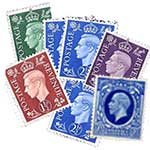
The main purpose of postage stamps is of course for sticking onto envelopes and parcels to confirm that the sender has paid for carriage to the recipient. This page elaborates. However, in the past, there were more uses. The page describes a lesser-known one: how stamps needed to be bought to show payment of a particular type of tax known as stamp duty. Another use was the very common hobby of stamp collecting which kept children and even adults occupied for many hours. This was because different denominations of stamps came in different colours with different heads of state on them. In the UK stamps always show the head on the monarch, as this page illustrates for the early to mid-part of the 20th century. The page also illustrates three ways of cancelling stamps once the payment has gone through: franking, signing over and perforating.
____
By the webmaster, based on firsthand recollections, firsthand contributions and discussions with older people
The head of the monarch on postage stamps
In the early part of the mid 20th century, stamps showed the head of George V and then briefly that of Edward VIII.
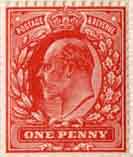
Edwardian one penny postage stamp
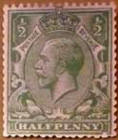
George V half penny postage stamp
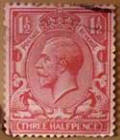
George V one penny postage stamp
Edward VIII was only king for a very short time as he abdicated in favour of George VI. Only four stamps were produced during his short reign. He broke with the tradition of of alternate monarchs' heads facing opposite directions.
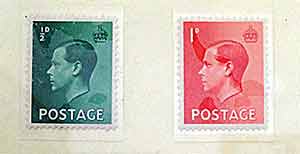
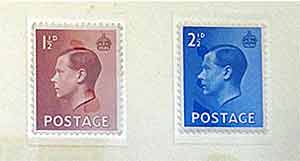
Edward VIII postage stamps
Photographed through glass at West Somerset Museum
Position of the crown on King Edward VIII postage stamps
contributed by Douglas Adam
Another interesting feature of the Edward VIII postage stamps is the position of the crown. Whereas the crown of the other monarchs is shown above their heads, these crowns were offset, because Edward VIII never had a coronation. He abdicated before it could take place and was known as the uncrowned king.
The earliest stamps in general use that I knew as a child showed the head of George VI, shown in the next section on stamp duty.
Then when George VI died, stamps showed the young head of Queen Elizabeth II. For pictures of these stamps, see the photo of postcards below which opens on click to a larger image.
Stamp duty
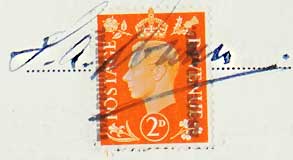
A George VI postage stamp used to show payment of purchase tax with the signature of the recipient across it.
As well as showing the amount paid on postage, stamps were also used to collect a tax. Stamp duty, as it was called, was a form of purchase tax, so called because it was paid with a postage stamp stuck onto the receipt of purchase. To show who was paying and to prevent the stamp being used afterwards for sending letters, etc, the person paying signed across the stamp, as shown in the picture.
Below is an example of stamp duty to collect tax earlier in the century.
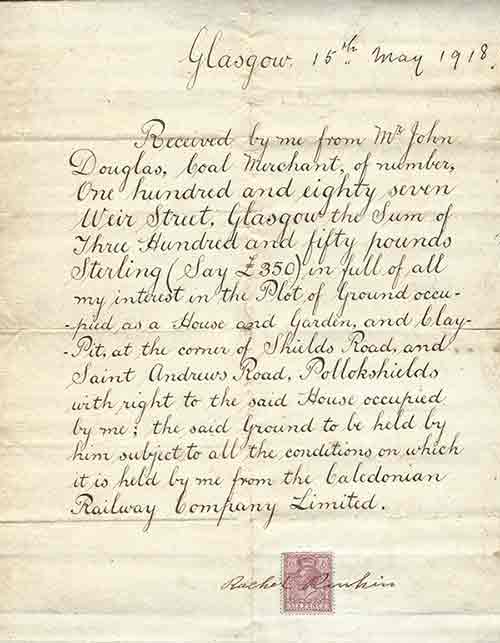
Receipt for house purchase in 1918 with a signature across a George V stamp, courtesy of Frank Jackson
Note the beautiful copper-plate handwriting that we could only achieve today with a computer.
Stamp duty on cheques
contributed by James Baker
Stamp duty was paid automatically whenever a purchase was made by cheque.
Cheque books came already embossed with the stamp duty payable, at 2d per cheque. Normally, (with Barclays), private customers were sold cheque books containing 24 cheques, for which 4 shillings was debited from their account. Business clients were sold books containing 60, 120 or 200, with proportionate charges.
The payment of stamp duty was indicated by means of an impressed stamp made manually by the counter hand. Then in 1956 banks were allowed to issue cheque books with the stamp duty mark already in place. The duty was abolished on 1 February 1971, shortly before decimalisation on 15 February 1971.
If a customer requested cash over the counter, he or she had to pay 2d for stamp duty using what was called a counter cheque.
How stamps were sold in post offices
I never saw books of stamps until much later in the century.
Stamps could be bought at a post office, but not in normal shops. They came in large sheets and whatever number one wanted to buy were torn off from the sheet. This was straightforward because every stamp was perforated round the edges to guide the tears. These perforation marks are visible round the edges of all the stamps in the photos on this page.
How stamps were sold in vending machines
There were coin-operated stamp machines outside post offices and in various other places. They were dispensed in strips from a reel, with no wrapping of any sort. There were no books of stamps.
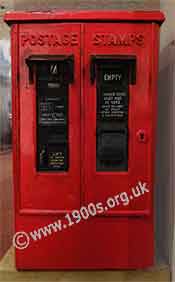
Coin operated stamp machine
The glue on postage stamps
All the stamps stuck onto the envelopes with a type of gum or glue that was non-sticky when dry and which had to be moistened to become sticky.
As with the flaps of envelopes, most people simply licked, although businesses had special arrangements of sponges in water.
Class of postage stamps
There was no such thing as a first or second class of postage before 1968. The Post Office simply dealt with all mail as quickly as possible rather than intentionally hold up second class - a much more efficient arrangement in my view.
Between 1892 until 1969 unsealed envelopes were cheaper to send which is how we always sent our Christmas and birthday cards. According to the British Postal Museum Archive, this was due to the Printed Paper Rate introduced in 1892, which allowed newspapers, pamphlets, and circulars to be sent at a reduced price1. Envelopes were sent unsealed to allow checkers to ensure that the regulations were observed or apply a surcharge.
Perforated markings on stamps - the alternative to franking
Today, effectively no business envelopes carry stamps. Instead, the businesses frank them before posting, to show that the cost of postage has been paid while also carrying publicity for the business. I can't remember any post (ie mail) being franked by the sender while I was growing up in the mid-20th century. Businesses used stamps like everyone else.
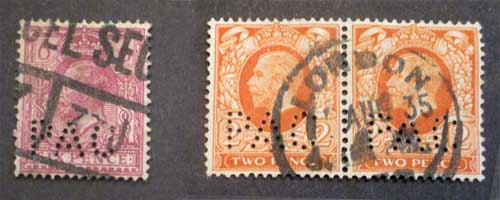
1930s postage stamps perforated with the PAC logo which stood for Prudential Assurance Company. Courtesy of Brian Read.
Yet large businesses did use their postage stamps to publicise themselves. They did so by perforating tiny holes into their stamps shaped as some sort of simple logo.
My aunt worked for the Prudential Assurance Company (PAC) and my family would always know from the envelope that a letter was from her because of the stamps were perforated with PAC - seem ne of her PAC postcards on the top of the pile of postcards.
In today's terms, these stamps were 'stolen' from the Prudential Assurance Company for my aunt's personal use, but she never thought of it that way. As she told me several times, "It's all right to take stamps!". Interesting - as she was otherwise of totally upright character.
| sources | webmaster | contact |
Text and images are copyright
If you can add anything to this page or provide a photo, please contact me.



